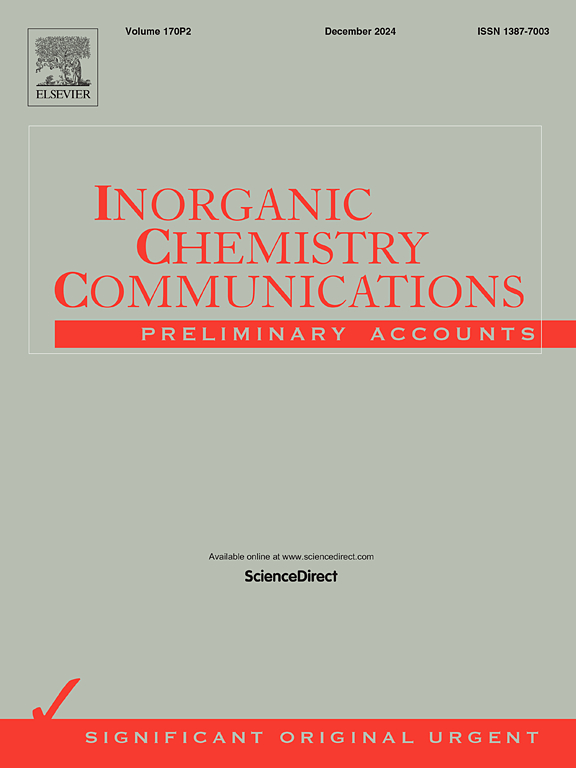Cd2+掺杂ZnTiO3及其硫化物纳米复合材料ZnxCd1-xTiO3@S协同作用增强光降解结晶紫
IF 4.4
3区 化学
Q1 CHEMISTRY, INORGANIC & NUCLEAR
引用次数: 0
摘要
本研究探讨了掺杂 Cd2+ 离子的 ZnTiO3 包晶结构及其相应的硫化物纳米复合材料在太阳辐射下的光催化功效。利用水热法合成了 ZnTiO3、ZnxCd1-xTiO3 光催化剂(x = 0.01、0.03、0.05)和不同硫含量(5%、10%、20% 和 30%)的 ZnxCd1-xTiO3@S 纳米复合材料。X 射线分析证实了合成样品的晶体结构。在摩尔比 x = 0.01(Zn0.99Cd0.01TiO3)的条件下,单相 ZnxCd1-xTiO3 完全形成了立方结构。晶体尺寸(nm)、晶格常数(Å)、单位晶胞体积(Å)3、晶格应变(ɛ)和位错密度(δ)等结构参数均来自 XRD 数据。TEM 显微照片显示,Zn0.99Cd0.01TiO3 呈立方体形态,而 Zn0.99Cd0.01TiO3@S 纳米复合材料则呈多壳空心结构,壳为六角形。XPS 光谱证实了 Zn0.99Cd0.01TiO3@S 纳米复合材料中 Cd2+、S2- 和 S6+ 的氧化态。利用 DRS 光谱和 Tauc 图估算了光催化剂的带隙能,结果显示,在 ZnTiO3 中掺入 Cd2+ 后,带隙能略有降低,从 3.27 eV 降至 3.25 eV,而硫的加入则导致带隙能进一步降低。尽管带隙能降低,表面积略有增加,但与纯 ZnTiO3 相比,掺杂 Cd2+ 离子的 ZnTiO3 在降解水晶紫方面的光催化活性较低(65.53% 对 75%)。相反,Zn0.99Cd0.01TiO3@S20 硫化物纳米复合材料表现出更高的性能,在最初的 30 分钟内实现了 96.40% 的降解率。清除剂研究发现,h+ 和 e- 是主要的反应物种,-OH 起着次要作用。利用伪零阶、伪一阶和伪二阶模型进行的动力学研究表明,Zn0.99Cd0.01TiO3@S 纳米复合材料在光降解活动中非常有效。本文章由计算机程序翻译,如有差异,请以英文原文为准。

Photo-degradation enhancement on crystal violet under sunlight via synergistic effect of Cd2+ doped ZnTiO3 and its sulfide nanocomposite as ZnxCd1-xTiO3@S
This research delved into the efficacy of photocatalysis in ZnTiO3 perovskite structures doped with Cd2+ ions and their corresponding sulfide nanocomposites when exposed to solar radiation. ZnTiO3, ZnxCd1-xTiO3 photocatalysts (x = 0.01, 0.03, 0.05), and ZnxCd1-xTiO3@S nanocomposites with varying sulfur contents (5, 10, 20, and 30 %) were synthesized utilizing the hydrothermal method. X-ray analysis confirmed the crystal structures of the synthesized samples. A single-phase ZnxCd1-xTiO3 with a cubic structure was achieved exclusively at the molar ratio x = 0.01 (Zn0.99Cd0.01TiO3). Structural parameters, such as crystallite size (nm), lattice constants (Å), unit cell volume (Å)3, lattice strain (ɛ), and dislocation density (δ), were derived from XRD data. TEM micrographs revealed cubic morphology for Zn0.99Cd0.01TiO3 and multishell hollow structures with hexagonal shells for the Zn0.99Cd0.01TiO3@S nanocomposite. XPS spectra confirmed the oxidation states of Cd2+, S2−, and S6+ in the Zn0.99Cd0.01TiO3@S nanocomposite. Band gap energies of the photocatalysts were estimated using DRS spectra and Tauc plots, showing a slight reduction, shifting from 3.27 eV down to 3.25 eV upon Cd2+ doping into ZnTiO3, while sulfur addition led to a further reduction. Despite a decrease in band gap energy and a marginal increase in surface area, Cd2+ ion-doped ZnTiO3 exhibited lower photocatalytic activity in degrading crystal violet compared to pure ZnTiO3 (65.53 % vs. 75 %). Conversely, the Zn0.99Cd0.01TiO3@S20 sulfide nanocomposite demonstrated superior performance, achieving 96.40 % degradation within the first 30 min. Scavenger studies identified h+ and e− as the major reactive species, with •OH playing a minor role. Kinetic studies employing models of pseudo-zero order, pseudo-first order, and pseudo-second order were performed, underscoring the effectiveness of the Zn0.99Cd0.01TiO3@S nanocomposites during the photodegradation activity.
求助全文
通过发布文献求助,成功后即可免费获取论文全文。
去求助
来源期刊

Inorganic Chemistry Communications
化学-无机化学与核化学
CiteScore
5.50
自引率
7.90%
发文量
1013
审稿时长
53 days
期刊介绍:
Launched in January 1998, Inorganic Chemistry Communications is an international journal dedicated to the rapid publication of short communications in the major areas of inorganic, organometallic and supramolecular chemistry. Topics include synthetic and reaction chemistry, kinetics and mechanisms of reactions, bioinorganic chemistry, photochemistry and the use of metal and organometallic compounds in stoichiometric and catalytic synthesis or organic compounds.
 求助内容:
求助内容: 应助结果提醒方式:
应助结果提醒方式:


